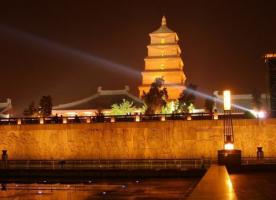Join-in Group Silk Road China Tours
About Us | Contact us | Tourist Map | Hotels | Feedback
Xian Attractions

Overview:Located 4 kilometers south of Xian City, the Big Wild Goose Pagoda is one of Xian’s most visited sights, along with the Terracotta Warriors.(Link) The pagoda is located in the Da Ci’en Temple complex.
Located 4 kilometers south of Xian City, the Big Wild Goose Pagoda is one of Xian’s most visited sights, along with the Terracotta Warriors.(Link) The pagoda is located in the Da Ci’en Temple complex.
According to legend, the pagoda got its name by an incident involving several Buddhist monks. During the Tang Dynasty Buddhist monks ate meat and one day the monks had no meat. They saw a group of wild geese flying overhead and a the monks said that he hopes that the Bodhisattva would send them meat. At that moment, one of the geese’ wings broke and it fell to the ground. All of the monks were shocked and at that point stopped eating meat. It is this incident which gave the pagoda the name ‘Big Wild Goose Pagoda’.
Built in 652 of the Tang Dynasty (618-907), the pagoda was built to store Buddhist Sutras brought back from India from the Buddhist monk Xuanzang. The monk traveled 17 years along the Silk Road to get to India and back home. He brought back 657 Buddhist Sutras, Buddhist Relics, and Buddhist Statues. Xuanzang was the first abbot of Da Ci’en Temple and supervised the pagoda’s construction.
The pagoda’s original height was 60 meters with 5 interior stories. It was built of rammed earth with a stone exterior. 50 years after its initial construction, the pagoda collapsed. In 704, the Empress Wu Zetian rebuilt the pagoda adding onto it, making it 10 stories high. In 1556, a massive earthquate damaged the pagoda and it was reduced by three stories to make it at its current height 64.5 meters high with 7 stories. In the Ming Dynasty (1368-1644), the pagoda was extensively repaired. Externally, the pagoda has four sides and is quite simple, yet elegant in design. Inside the pagoda is a spiraling staircase which allows visitors to climb the pagoda and get a bird’s eye view of the surrounding area. Each floor has four arched openings on each of its four sides. The walls are engraved with images of the Buddha which were carved in the Tang Dynasty.
Da Ci’en Temple
The temple complex which houses the pagoda was built in 648 to commemorate the death of a queen. The Emperor ordered the temple built and named it ‘Ci’en’, which means Mercy and Kindness. It was the largest and most beautiful temple in the country at that time. The temple today, occupies an area of 32,314 square meters, one seventh of the temple’s original size. The temple is dotted with ancient relics, and small garden areas. The temple’s beauty and peaceful atmosphere make it a wonderful addition to all China tours.


